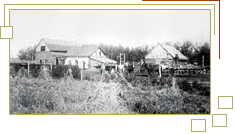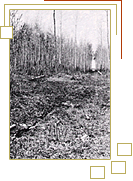|
 |
Early Settlement of Bonnyville (1907 - 1919) - Page1
by H.E. Bourgoin
Alexander Dargis's family, 1907
|
 |
Bonnyville owes its origin
to the concerted efforts of courageous, colonizing priests
such as the Oblate Fathers Rev. Joseph Adeodat Therien and
Rev. J.A. Ouellette who travelled, as early as 1907, to
Quebec, the Maritimes, and parts of the United States to
recruit colonists for parts of Alberta including St. Paul,
Therien and Bonnyville.
In 1910, the Rev. Father J.A. Ouellette published a pamphlet
which presents this work. The following is from the first
page of Rev. Ouellette's document:
To My Dear Compatriots: "For the past four years I
have been actively occupied with the work of colonization
by acquainting my compatriots with the real advantages that
are to be found in Central Alberta on the double point of
view of commerce and especially agriculture. I have the
satisfaction that my efforts were not wasted, for a goodly
number of settlers have answered my call, and those now
find themselves in a position which is quite promising for
the future.
I understand the responsibility of my mission, and by taking
advantage of past experience, I believe it to be useful
and even necessary to put into a small pamphlet a few notes
gleaned here and there in the course of my travels through
Central Alberta; those will serve as a sure guide to those
who wish to come and take their part of the heritage which
our country is placing at their disposal.
The condition of the colonist in Alberta as anywhere else
is not without difficulties, let no one have any illusions
on that point; it is true that the soil is rich, that the
climate is beautiful, that this part of the country holds
many advantages for tradesmen and workmen, but still, one
must settle down somewhere, one must make new acquaintances
and overcome his longing for his native parish. He must
set to work in order to build a new home and he must undergo
a style of life that is characteristic of the Canadian West.
Nevertheless, to all men who are sobre, industrious and
thrifty, we can promise easy circumstances, prosperity and
happiness".
Wilfrid Ouimet's farm, 1908
|
 |
Travel to the Moose Lake area
was no mean task in those days. From the south one could
get to Strathcona via the Canadian Pacific railway then
cross the North Saskatchewan River by ferry to Edmonton.
This ferry was a large pontoon held by pulleys that travelled
a steel cable stretched from shore to shore. When the pontoon
was maneuvered to the proper angle to the cable the force
of the river's current drove it forward. Just imagine this
ferry crossing the river laden with passengers, all their
goods, stock, and vehicles.
From Edmonton one could travel east on the Canadian Northern
Railway the seventy five miles to Vegreville where he would
begin the sixty five mile trip overland often by a stage
coach or freight wagon to St. Paul des Métis (a twelve
square mile reserve for the Métis founded in 1896
by Father A. Lacombe O. M.I.) via the Duvernay (thirty five
miles north of Vegreville) ferry across the north Saskatchewan
River.
From St. Paul des Métis one travelled to Moose Lake
as best he could on foot or perhaps on a freight wagon loaded
with merchandise for northern stores.
Some travelled all the way from Edmonton by horse and buggy,
or heavy springless team drawn wagon. These followed a trail
beaten by heavily laden freight wagons along the north shore
of North Saskatchewan River to Brosseau where they picked
up the trail to St Paul des Métis and Bonnyville.
These trails followed the cleared ways made by surveyors,
Indian trails, and capitalized on the occasional clearing.
One can imagine those trails on rainy days. One can hear
the heavy wheels' iron bands grinding on the boulders of
rocky sections. Sometimes the wagons would bog down along
the edge of sloughs. When this happened the wagons had to
be unloaded, pulled out of the mire, then reloaded before
it was possible to continue.
Trail at Anshaw
|
 |
It was in the early spring
of 1907 that Rev. Father Therien saw the first evidence
of success in his colonizing efforts. He had gone to visit
friends at Beaumont, a small French Canadian settlement
some fifteen miles south of Edmonton. There he succeeded
in challenging Philorome Ouellette age 25, Wilfrid Ouimet
age 45, Albert Dargis age 21, to venture into the Moose
Lake area. They were joined by Honorius Lamoureux age 24.
With the snow still on the ground they began to load two
sleighs and provisions, blankets, a tent, cooking utensils
and oats for the horses. Honorius Lamoureux rode with Wilfrid
Ouimet, Albert Dargis with Philorome Ouellette. Leaving
Beaumont, the four brave men travelled north to the North
Saskatchewan River, crossed it, climbed the hills and turned
east onto the Freight Trail along the river to Brosseau.
There they turned north and headed toward the Saddle Lake
Indian Reserve some ten miles away. There, at the Mission
of the Holy Heart, they were warmly welcomed by Rev. Father
Balter O.M.I. who served them a succulent meal and put them
up for the night.
Next morning they were on their way eastward. After covering
some fifteen miles they arrived at St. Paul des Métis
the afternoon of Easter Sunday. They had been on the road
seven days. After an overnight stop they hired a guide surnamed
Boudreau and set off for their 45 mile trip into the "wilderness".
Towards evening two days later they saw the waters of Moose
Lake. There they stopped and there they spent the night.
During the next few days they explored the surrounding land.
All except Honorius Lamoureux decided that this was, indeed
the place they wished to settle. They returned home to pack
up their belongings and friends. Towards the end of May
1907 our first eight pioneers arrived: Wilfrid Ouimet, Albert
Dargis, Philorome Ouellette plus Aime Marcotte, Hormidas
Boisvert, Joseph Mercier, Oliva Martel and Come Ouimet.
They found the land thickly wooded and dotted with lakes
and sloughs. Frequently these sloughs were fringed by meadows
on which stock could be pastured and from which succulent
hay could be gathered. Much of the land around the lakes
was rocky, but in general among the innumerable trees and
under the fallen tree trunks and layers of leaves they found
a thick layer of fertile black soil.
|
 |
|